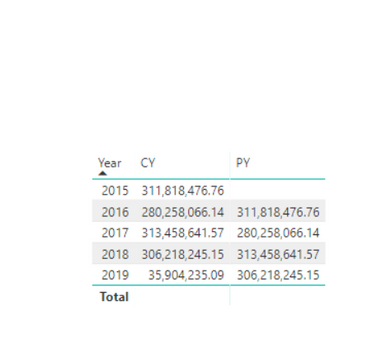- Power BI forums
- Updates
- News & Announcements
- Get Help with Power BI
- Desktop
- Service
- Report Server
- Power Query
- Mobile Apps
- Developer
- DAX Commands and Tips
- Custom Visuals Development Discussion
- Health and Life Sciences
- Power BI Spanish forums
- Translated Spanish Desktop
- Power Platform Integration - Better Together!
- Power Platform Integrations (Read-only)
- Power Platform and Dynamics 365 Integrations (Read-only)
- Training and Consulting
- Instructor Led Training
- Dashboard in a Day for Women, by Women
- Galleries
- Community Connections & How-To Videos
- COVID-19 Data Stories Gallery
- Themes Gallery
- Data Stories Gallery
- R Script Showcase
- Webinars and Video Gallery
- Quick Measures Gallery
- 2021 MSBizAppsSummit Gallery
- 2020 MSBizAppsSummit Gallery
- 2019 MSBizAppsSummit Gallery
- Events
- Ideas
- Custom Visuals Ideas
- Issues
- Issues
- Events
- Upcoming Events
- Community Blog
- Power BI Community Blog
- Custom Visuals Community Blog
- Community Support
- Community Accounts & Registration
- Using the Community
- Community Feedback
Register now to learn Fabric in free live sessions led by the best Microsoft experts. From Apr 16 to May 9, in English and Spanish.
- Power BI forums
- Forums
- Get Help with Power BI
- Desktop
- Re: Calculate CY and PY Sales based on Year Select...
- Subscribe to RSS Feed
- Mark Topic as New
- Mark Topic as Read
- Float this Topic for Current User
- Bookmark
- Subscribe
- Printer Friendly Page
- Mark as New
- Bookmark
- Subscribe
- Mute
- Subscribe to RSS Feed
- Permalink
- Report Inappropriate Content
Calculate CY and PY Sales based on Year Selected
 Sample Data
Sample DataSolved! Go to Solution.
- Mark as New
- Bookmark
- Subscribe
- Mute
- Subscribe to RSS Feed
- Permalink
- Report Inappropriate Content
Hi @Anonymous
Create a new table with this formula
Table = VALUES(Sheet2[Year])
Sheet2 is the table as your example data.
Don't connect this "Table" with Sheet2, it means the two tables should have no relationship.
Add Table[year] in the slicer, create measures in "Sheet2".
Selected year = SELECTEDVALUE('Table'[Year])\
CY = CALCULATE(SUM(Sheet2[Sales]),ALLSELECTED(Sheet2))
PY =
CALCULATE(SUM(Sheet2[Sales]),FILTER(ALL(Sheet2),[Year]=[Selected year]-1))
Best Regards
Maggie
Community Support Team _ Maggie Li
If this post helps, then please consider Accept it as the solution to help the other members find it more quickly.
- Mark as New
- Bookmark
- Subscribe
- Mute
- Subscribe to RSS Feed
- Permalink
- Report Inappropriate Content
Hi @Anonymous
Create a new table with this formula
Table = VALUES(Sheet2[Year])
Sheet2 is the table as your example data.
Don't connect this "Table" with Sheet2, it means the two tables should have no relationship.
Add Table[year] in the slicer, create measures in "Sheet2".
Selected year = SELECTEDVALUE('Table'[Year])\
CY = CALCULATE(SUM(Sheet2[Sales]),ALLSELECTED(Sheet2))
PY =
CALCULATE(SUM(Sheet2[Sales]),FILTER(ALL(Sheet2),[Year]=[Selected year]-1))
Best Regards
Maggie
Community Support Team _ Maggie Li
If this post helps, then please consider Accept it as the solution to help the other members find it more quickly.
- Mark as New
- Bookmark
- Subscribe
- Mute
- Subscribe to RSS Feed
- Permalink
- Report Inappropriate Content
Hello @v-juanli-msft
Thanks for your help. I applied your solution and it's working perfectly with a minor chage to CY.
The CY measure
CY = CALCULATE(SUM(Sheet2[Sales]),ALLSELECTED(Sheet2))
is giving total sales of all years. So, I changed it to
CY = CALCULATE(SUM(Sheet2[Sales]),FILTER(ALL(Sheet2),Sheet2[Year]=Sheet2[Selected year]))
- Mark as New
- Bookmark
- Subscribe
- Mute
- Subscribe to RSS Feed
- Permalink
- Report Inappropriate Content
Hello @v-juanli-msft,
How can I calculate YTD Sales for CY and PY based on year selected?
Regards,
James Arthur
- Mark as New
- Bookmark
- Subscribe
- Mute
- Subscribe to RSS Feed
- Permalink
- Report Inappropriate Content
Hi @Anonymous
Does the previous measure not help?
How about this DAX function TOTALYTD which evaluates the year-to-date value of the expression in the current context?
Best Regards
Maggie
Helpful resources

Microsoft Fabric Learn Together
Covering the world! 9:00-10:30 AM Sydney, 4:00-5:30 PM CET (Paris/Berlin), 7:00-8:30 PM Mexico City

Power BI Monthly Update - April 2024
Check out the April 2024 Power BI update to learn about new features.

| User | Count |
|---|---|
| 104 | |
| 96 | |
| 79 | |
| 65 | |
| 62 |
| User | Count |
|---|---|
| 147 | |
| 116 | |
| 104 | |
| 88 | |
| 65 |


